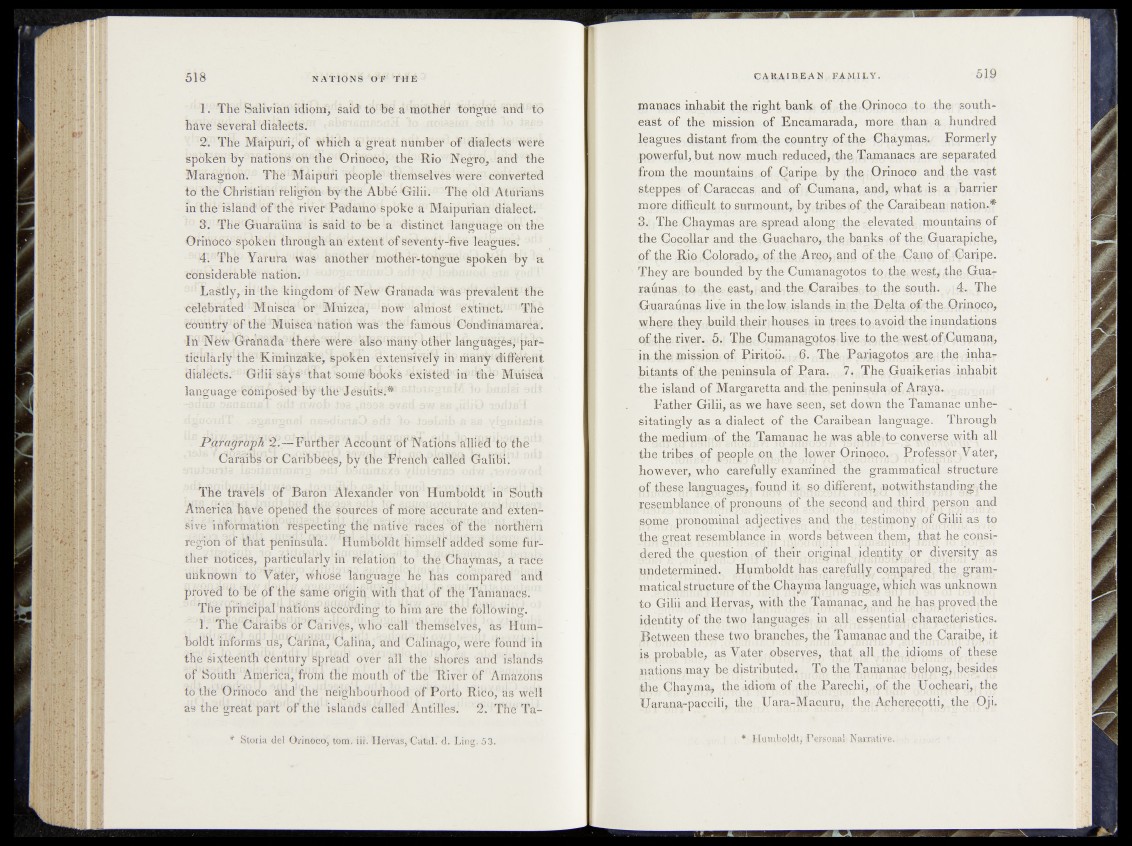
I I lij
’ 1. Thé Saliviatt ïdièlrfy^saM tè be a möthëf tongue ifeddb
have several dialects.
2v The MaipUri, of which agreat number of dialects were
i^blféh'4^0hSifièiSi'b,h!Hne? Oiiü&tëö; ythe Rio¥*Wte^¥b, ärid the
Mafegriohv Thë-'-M&ifNhfi '^Jeo^lè1 tffeihsëli^iRréSfëf' cöèv^tëel
to the Chriëtiïfe fèli^Om by^hë Äb&e feilii.3 The old Atürraiïs
ih th è^ lifed JOffeé rivef Padafoó Spdke a Maipurian dialect.
?t; g. The Guataüiia is said to be adiistinct lan^üêgé bn the
OHhbeo^Spöken through' an1 extent öfséVenty-ffVe lea^tiës? i!
4.: Thë Yarura 3 Was Biiöthëir méfeéfdongee Spokéh by - a
itóhsïdeihMh haöbhi ’f
9" Lastly, in the kingdom öf New Granada "Wäs ptevaleht the
celebrated Muis^aj br;: MuSzeè‘7GiïtoW0%lMc^i 3diythfötiJß,,!Th4
W&täHf ?Öf the M uïéëb-!hètiön Was the *fèthÓlu# ’ GdhdibiäÄki4&l
I Iff 8 WT^äriäda1 feéib YfóérIP hlSo rfeSMy other lénglè^ë^^alP-
tföiflè.rFyl thëiKïmin^he>hj)Okèn >exté1Èi§ivèIy ih rilä^'^ffemfit
3ftfle^s.eßl©8if^5y#ftniat ^sonf^bookS !%%e° Muisca
language cÖmposéd^ by tlie” J éétófél*
- P'ära^dj^h urthéf Adooftbt ‘8fiSfa^öÄs1^liiÄxt9*lth'l1” -
Caraibiror Cérïbbèeë, by tbe ^te^^'èbllè^ Öaßöil.lj
Thé tj^vêik’ ‘öf Batpïi Aïéxhndér n^B4ï>' iS8Sohth
Ahiericé have1 opened me 0 üréés of
sive iffKUTnmiwmTe&p^^ng thé native'"races of thé' northern
region of that pénihsuia'. '* Hum Bold t hihï'sëlf added Some further
notices, particularly fff relation: to the Ghaymas, a f äees
unknown tö Väter, whose läriguägeghe has compared and
p(oVed tobe óf'thé séme bVigin with that of the "Tdman'acS;''
The ptincipaTnpfoim ac c^m gTb him afe the following.
1. The CafeibS'or'Cäriyes/' who Call themsèl'veS,as'*1Hura-
bold't IhformsVsyX^fiTO^^aHiih, and' Calinago, wereTóühd ‘in
the sitihenth'Century1 ^prem pyePalf the' shores äihd islands
of Öóütlï'America/Troth the mouth of 'thé River of Arhazdhs
to thé ÖrihóCo vähd‘ thé1héTghbó'brhoód of Porto Rico/as well
ab feélgreai paft of the1 islatïdé called Antilles.'!jjWÈ The: Ta-
* Storia del Orinoco^ tom', iii. HerfaspOatal. d. Ling. 53.
manacs inhabit the Tight bank of-feqTQrfeqpq do the southeast
of the mission of Encamarada, mqre0jfeani n hundred
leagues distant from the country o f the Chayinas./ l^iprmerly
.powerful, but now much; ^ e ?^epajr.ated
from the mountains of Caripe .-by rfepiQfenqfre andfeeypst
$teppesrof Iparaecass and pfjjDugiana,apd,j,pfepkii?'f!a barrier
more dipicult rtp sqrrpqjifd® b$ffehesio£ fe f £?arafe§iani .Rat|w%#
.4.: ;Tbe,phuymas arq#pj;ead along the elevated mountains of
the Qogbbur apd thev^uughap^^fti^SnbS'iSf
qf fee rRio ,jQ^l^|a4^Jif tbefArspitSHi nfri$a3Pe’
■They are bounded by the Cumanagotos tqd^sfaW^y
jpunps,|to fee? ppsk,foUBShfees<£^feb8fofe>tifap j§!?Pffe% a i4» The
tl|i|t|araupuhfee j»f
jqf^h^riv.er. 5.j Th^.jQufpjap^gK^ofTl^efed^^WMfc^^P^1^
IPofe© ^tssipp; qf
jbitapts objtheipqniqspla ;qff>P(arp>jnr7 . Tbey(gfuai^0iaso^n,h(ftJliJ'
the island of Margaretta aaidj fllC) pepins.ula q|l Ar^y^..,,,
Father Gilii, as we have seen, set down the Tamanac unhesitatingly
as a dialect of the Caraibean langu^eipi Through
the, mediurririOf_ the Tamaqac l^e wasuW,©]
the tribes..of peopjeonThe IftW.er OfinpjCOv-. ProfessQVjVater,
however^who carefully examined the grammatical structure
of. fegse lamguagqSsT found | ib.MQ «otwifestandingrthe
fesemW^pqe.Qfnropqpns pf feeaa^cmd-and tliird pemon aryl
sorpe.
the* gr,ea| resend>lance ip wpi^di s epn^ijdered
feq 'aussfe)»j or th el r qpgi nal i^nhte^Qr myerei tyqJ a§
undeterpiined- Humb^oldt has^ cpremlly conm^eiit
maticalstrbftur{q qf thq iC ^ y ^ a japgu^ge^ wbi% w^s pn^np^n
to Gilii and Bervqp, witli tpe Tappnam mad he has nrpved|tbh
identity of fee^^twq l,apgppgC^,m „afe eerentiak ghl^CR^psacs.
Between these twq branches, fee Tumanaq and fee rpprBfeq*.if
is prqbpbl?? ^§te^j p ^ r v ^
nati°n? ,>may bp,distnhutpd<, .Tq. thpr
feq Qhavipa^ feeddiptpi ofjfep(^ Pw^?bii rffff,fee f
Uerap%'paccili,. fee, Uaran^j,amirm9 ; t % { t h e . ; O j i-
* Humboldt, ’Peigoaiali NamitiVp.’
w